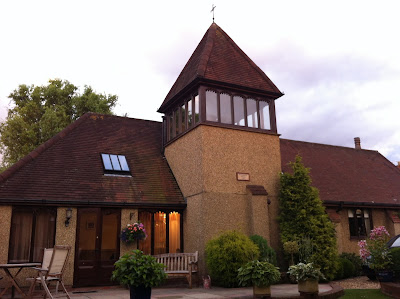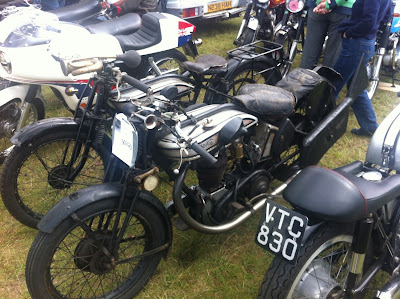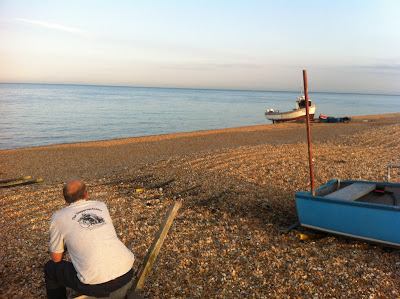Door John
 |
| The White Cliffs of Dover |
Vrijdagochtend de 16de vertrokken Rob en John in alle vroegte naar Duinkerken om aldaar de boot naar Dover te nemen. Nog steeds optimistisch ondanks dat we alleen een kaartje voor de auto hadden en niet voor de aanhanger: "regelen we daar wel". Hetgeen lukte maar alleen na heel hard heen - en - weer rennen, bijbetalen en de zenuwen vanwege erg weinig tijd; we waren werkelijk de laatste auto die de boot op mocht. DFDS Seaways hanteert tegenwoordig een
zero-tolerance beleid; te laat, te vroeg of een verkeerd kaartje betekent een gesprek met een onverbiddelijke juffrouw bij een loket en het trekken van de poeplap;
waarover later meer. De bootreis zelf verliep echter voorspoedig en na twee uur varen zagen we de White Cliffs of Dover.
Met de autoreis wilde het niet vlotten door een enorme file op de M25 en aan het begin van de avond arriveerden we bij onze Bed & Breakfast in het plaatsje Alton in Hampshire.
 |
| St Mary's Hall |
 |
| Eikenhouten kerkramen in de slaapkamer |
 |
| Fornuis in het voormalig altaar |
B & B '
St Mary's Hall' is gevestigd in een voormalige katholieke kerk; wat ons betreft een prima bestemming voor een kerkgebouw. Het was geen bijzonder fraaie kerk maar het heeft toch wel iets, de kerkramen in de kamers en het gasfornuis in het voormalige altaar. Bovendien mochten de Nortons in de schuur slapen naast de Harley van Jack en Joan, de uitbaters.
 |
| Ontbijt! |
 |
Twee 1928 platte tank kopklep Nortons;
veel beter kan het niet! |
De volgende ochtend een heftig ontbijt en de Nortons aangetrapt. Op weg voor een stevige rit naar Verralls.
Rob heeft eindelijk een goede oplossing gevonden voor het TomTom probleem;
een 10.000 mAh accu van het merk Energenie. Fantastisch ding, de TomTom heeft er drie dagen op gewerkt zonder bijladen en was nog steeds niet leeg. Hij kost zo'n 40 euro en je kunt er ook je mobiel met lege batterij op aansluiten. Met de TomTom kun je probleemloos de weg vinden over de hele kleine weggetjes; met slechts twee man op twee Nortons ga je bovendies hard, ongeveer twee keer zo snel als tijdens de gebruikelijke rit op VMC/DVMA snelheid ... heerlijk!
 |
| De M18s bij Verralls |
 |
| Springende haas bier |
Bij Verralls weer bijgepraat (oa. over Nortons) met de inmiddels goede bekenden Ian en Gordon. De Fish & Chips hebben we af kunnen slaan om een lunch met een prima "Hopping Hare" biertje te nuttigen in de pub.
 |
| The George in Alton |
 |
| Op de WC deur van The George |
's Middags verder gereden naar Simon, een van de mannen achter de
Vintage Norton website en hem uitgenodigd voor een diner in de pub "The George" waar we het de hele avond hebben gehad over ... Nortons!
 |
| Popham Jumble |
 |
| 1924 M18 en 1927 M18 |
De volgende dag naar de beurs op Popham Airfield; niet veel bijzonders gevonden maar wel leuk om even te zien.
 |
| Simon |
Daarna weer naar Simons huis en daar hebben we het de hele middag gehad over ... Nortons! En een beetje over tuinieren en huizen. Simon woont in een cottage van zo'n 400 jaar oud gelegen in een prachtige tuin.
 |
| ... and now you fit this like this ... |
Aan het eind van de middag de M18s maar weer gestart en een flinke rit naar Midhurst. Wederom een prachtige rit met dank aan de TomTom, onderbroken door de diner bij het plaatselijke Indiaas restaurant.
 |
| Stanley Woods |
 |
| Jimmy Guthrie |
De volgende dag op bezoek bij Roger, een van de mannen van het Brooklands Museum. Ook bij hem gind het over ... Nortons! Roger is de eigenaar van een van de beroemdste platte tank Nortons,
LPD1. Terug naar Alton via het huis van Jane Austin, dochter van de beroemde autofabrikant.
 |
| Op bezoek bij Roger |
 |
| Jane Austin's House |
Daarna nog even met Simon bijgepraat over ... Nortons ... en weer op weg richting huis Wederom hadden we geen kaartje voor de aanhangwagen: "regelen we daar wel" wat ook nu een minder goed idee bleek omdat we gehoopt hadden de boot van 18.00 uur te nemen en we van de juffrouw een kaartje kregen voor 24.00 uur! Uiteraard probeerden we het nog bij twee andere lokkettistes maar beide dames zagen alleen problemen en stuurden ons weer weg.
 |
| ... wachten op de boot ... |
Dus maar terug naar Dover voor een Indiaase maaltijd om het om 21.00 nog maar eens te proberen; nu zat er een meneer achter het loket en die had ons
binnen een kwartier op de boot naar Calais. Calais is 20 minuten verder rijden in Frankrijk maar als dat 3 uur wachten scheelt is het de moeite waard. Het was midden in de nacht rustig op de weg dus ruim voor zonsopgang weer in Nederland tussen de klamme lappen bij Moeder de Vrouw.






















